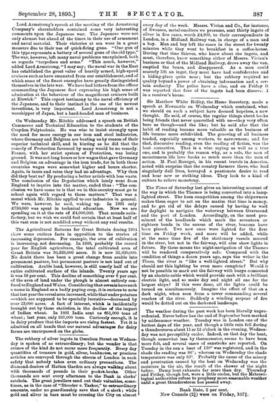The Times of Saturday last gives an interesting account of
the way in which the Thames is being converted into a lamp- lighted street. The keen competition among the shipowners makes them eager to act on the maxim that time is money, and to get rid of the delays caused by having to wait for daylight to navigate the waterway between Gravesend and the port of London. Accordingly, on the most pro- minent of the headlands which mark the seventeen or eighteen bends in the course of the river, beacons have been placed. Two new ones were lighted for the first time on Friday week, and more will be added, while at the same time five of the stationary vessels moored in the river, but not in the fairway, will also show lights in future. By these means the night-navigation of the Thames will be rendered comparatively safe. Compared with the condition of things a dozen years ago, says the writer in the Times, the river is "like a well-lighted street." But why should not this lighting be even more complete? Would it not be possible to mark out the fairway with buoys connected by an electric-cable which would provide each with a brilliant electric light, and so make day and night all one for the largest ships P If this were done, all the lights could be turned on simultaneously. Imagine the effect of that on a dark night, when seen from a tower commanding several reaches of the river. Suddenly a winding serpent of fire would be dotted out on the darkened landscape.






































 Previous page
Previous page